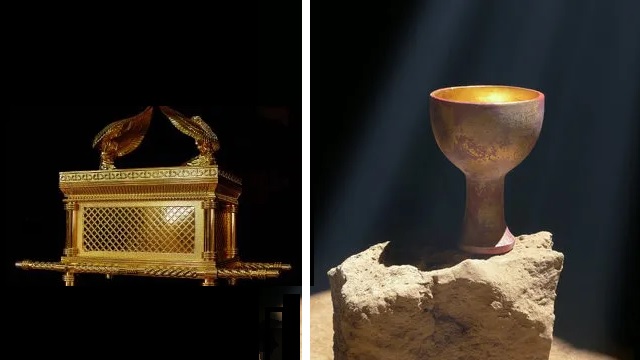Where are the Ark of Covenant and Holy Grail Buried?

We have always been interested in where the two most important and holiest relics in Christian history are buried—the Arc of the Covenant and the Holy Grail.
It is believed that it was the Knights Templar who took the Arc of the Covenant and the Holy Grail with them to keep them from being destroyed by the invading Muslim armies.
According to the History Channel,
The Knights Templar was a large organization of devout Christians during the medieval era who carried out an important mission: to protect European travelers visiting sites in the Holy Land while also carrying out military operations. A wealthy, powerful and mysterious order that has fascinated historians and the public for centuries, tales of the Knights Templar, their financial and banking acumen, their military prowess and their work on behalf of Christianity during the Crusades still circulate throughout modern culture.
After Christian armies captured Jerusalem from Muslim control in 1099 during the Crusades, groups of pilgrims from across Western Europe started visiting the Holy Land. Many of them, however, were robbed and killed as they crossed through Muslim-controlled territories during their journey.
Around 1118, a French knight named Hugues de Payens created a military order along with eight relatives and acquaintances, calling it the Poor Fellow-Soldiers of Christ and the Temple of Solomon—later known simply as the Knights Templar.
With the support of Baldwin II, the ruler of Jerusalem, they set up headquarters on that city’s sacred Temple Mount, the source of their now-iconic name, and pledged to protect Christian visitors to Jerusalem.
Initially, the Knights Templar faced criticism from some religious leaders. But in 1129, the group received the formal endorsement of the Catholic Church and support from Bernard of Clairvaux, a prominent French abbot. Bernard authored “In Praise of the New Knighthood,” a text that glorified the Knights Templar and bolstered their growth.
In 1139, Pope Innocent II issued a Papal Bull that allowed the Knights Templar special rights. Among them, the Templars were exempt from paying taxes, permitted to build their own oratories and were held to no one’s authority except the Pope’s.
Many have searched for these holiest of holy relics and now it appears someone knows where the Knights Templar may have buried them.
In a July 30, 2023 article Jolt of Joyful reported,
A highly respected historian thinks he may have figured out where the Ark of the Covenant and Holy Grail were buried by the Knights Templar. No, we’re not talking about Indiana Jones. David Adkins, an anthropologist and historian, believes the two ancient relics may be found under a famous landmark in England.
Adkins, who first proved his mettle when he tracked down a 10,000 year-old skull called “Greta,” argues that “the lost treasure of the Knights Templar could be concealed in a labyrinth of tunnels and chambers underneath Sinai Park House,” a historic building that dates back to the 13th century in the town of Burton.
The imposing landmark in Burton may be lying on caverns vast enough to contain Westminster Abbey, according to one geologist, writes The Brighter Side.
David is now keen to try and locate the treasures plundered by the Knights Templar during the crusades – which could potentially include the golden Ark of the Covenant, which housed the 10 commandments, and even the Holy Grail.
WATCH: Historic England House Could Contain the Holy Grail
Ron Wyatt has also searched from 1979 into the 1980s and found what he believes to be the burial place of the Arc of the Covenant.
WATCH: Ron Wyatt summarizes original findings in ‘Ark’ chamber and performs sub-surface radar scans.
WATCH: Dangerous underground excavations explore radar anomalies.
WATCH: Ron Wyatt – Chromosome count in ‘blood’ sample.
We have Ron Wyatt who in the 1980s believes that he found the Arc of the Covenant. And we now have anthropologist and historian David Adkins who believes the that the Arc of the Covenant and the Holy Grail may be found under a famous landmark in England.
Seeing is believing! And I hope that I get to see these two holy relics.
Israelmore Ayivor wrote, “It takes the trust of God for things that exist, to wait on him for the evidence of things that do not exist. Faith and hope make you to thank God for the invisible things by looking at the visible things which were once invisible too.”
We agree.
We can’t wait for someone driven by the hand of God discover his Ten Commandments and the cup which His Son Jesus passed among his disciples as reported in Mark 14:24 saying, “And he said unto them, This is my blood of the new testament, which is shed for many.”
Amen.
©2023. Dr. Rich Swier. All rights reserved.


Leave a Reply
Want to join the discussion?Feel free to contribute!